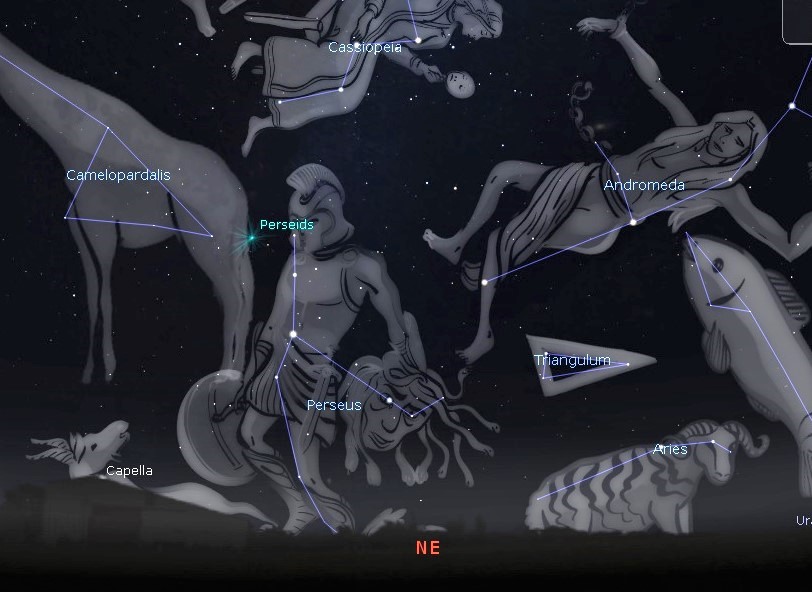This Week’s Sky at a Glance, 2022 August 13 – 20
~by Curt Nason
You can see a few meteors per hour on any night in a clear dark sky, but the number increases greatly when Earth passes through a trail of pebbles and dust left by a comet that makes frequent orbits around the Sun. The pebbles left by comet Temple-Tuttle in its 133-year orbit are quite large at a few centimetres, and they enter our atmosphere at a high relative velocity of 60 km/s (Earth travels at 30 km/s). Therefore, they can be very bright. The Perseids will seem to be coming from a point between the constellations Perseus and Cassiopeia, which are highest in the sky in early morning. You will see fewer in the evening but they tend to be long and bright.
Meteors, also called shooting stars or falling stars, are the streaks of light created when pebbles enter the atmosphere at an altitude of about 100 kilometres, and those particles from comets disintegrate before they reach an altitude of 50 kilometres. Many meteors are faint and easily made invisible by moonlight and light pollution. This weekend the Perseid shower occurs with the Moon just a day or two past full, but don’t let stop you from going out to watch. Get comfortable in a chair, have extra clothes or blankets if you plan to stay long as it can get very chilly, and select a patch of sky that is free of clouds and direct light. It is better to keep Perseus to your side rather than look in that direction because the meteors will look more spectacular, covering a longer distance.
This Week in the Solar System
Saturday’s sunrise in Moncton is at 6:16 am and sunset will occur at 8:31 pm, giving 14 hours, 15 minutes of daylight (6:23 am and 8:34 pm in Saint John). Next Saturday the Sun will rise at 6:24 am and set at 8:19 pm, giving 13 hours, 55 minutes of daylight (6:31 am and 8:22 pm in Saint John).
The Moon passes below Jupiter on Monday and approaches Mars as it reaches third quarter phase on Friday. Saturn is at opposition on Sunday, a time when its icy rings look brighter as they reflect sunlight directly toward us. Telescope users might see the shadows of moons Io and Ganymede crossing the clouds of Jupiter late Monday night, beginning at 12:24 and 12:59 am, respectively. This double shadow transit will last until Io’s shadow egresses at 2:38 am. Mercury sets 45 – 50 minutes after sundown, and Venus passes near the Beehive star cluster in Cancer on Tuesday morning. The Perseid meteor shower peaks this Saturday morning and it could still bring several smiles to our faces that evening and Sunday morning.
On Sunday evening at 8 pm, tune in to the Sunday Night Astronomy Show via the Facebook page or YouTube channel of Astronomy by the Bay.
Questions? Contact Curt Nason.

